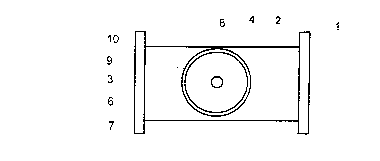Some of the information on this Web page has been provided by external sources. The Government of Canada is not responsible for the accuracy, reliability or currency of the information supplied by external sources. Users wishing to rely upon this information should consult directly with the source of the information. Content provided by external sources is not subject to official languages, privacy and accessibility requirements.
Any discrepancies in the text and image of the Claims and Abstract are due to differing posting times. Text of the Claims and Abstract are posted:
| (12) Patent Application: | (11) CA 2261583 |
|---|---|
| (54) English Title: | DEVICE FOR TUNING A MICROWAVE SYSTEM |
| (54) French Title: | DISPOSITIF POUR ACCORDER UN SYSTEME A HYPERFREQUENCE |
| Status: | Deemed Abandoned and Beyond the Period of Reinstatement - Pending Response to Notice of Disregarded Communication |
| (51) International Patent Classification (IPC): |
|
|---|---|
| (72) Inventors : |
|
| (73) Owners : |
|
| (71) Applicants : |
|
| (74) Agent: | SMART & BIGGAR LP |
| (74) Associate agent: | |
| (45) Issued: | |
| (86) PCT Filing Date: | 1997-07-07 |
| (87) Open to Public Inspection: | 1998-02-05 |
| Availability of licence: | N/A |
| Dedicated to the Public: | N/A |
| (25) Language of filing: | English |
| Patent Cooperation Treaty (PCT): | Yes |
|---|---|
| (86) PCT Filing Number: | PCT/DE1997/001463 |
| (87) International Publication Number: | WO 1998005086 |
| (85) National Entry: | 1999-01-20 |
| (30) Application Priority Data: | |||||||||
|---|---|---|---|---|---|---|---|---|---|
|
A tuning device which allows the fast periodical frequency tuning of a
microwave system with simple mechanical means consists of one or several
tuning elements (2, 3) which project into a wave guide (1) and are mounted to
rotate around an axis (4) perpendicular to the longitudinal axis of the wave
guide.
L'invention concerne un dispositif d'accord, permettant, avec un mécanisme peu complexe, de modifier rapidement l'accord des fréquences d'un système à hyperfréquence. Ce dispositif comprend un ou plusieurs éléments d'accord (2, 3) faisant saillie à l'intérieur d'un guide d'ondes (1), lesdits éléments étant montés de façon à pouvoir tourner autour d'un axe (4) perpendiculaire à l'axe longitudinal du guide d'ondes.
Note: Claims are shown in the official language in which they were submitted.
Note: Descriptions are shown in the official language in which they were submitted.

2024-08-01:As part of the Next Generation Patents (NGP) transition, the Canadian Patents Database (CPD) now contains a more detailed Event History, which replicates the Event Log of our new back-office solution.
Please note that "Inactive:" events refers to events no longer in use in our new back-office solution.
For a clearer understanding of the status of the application/patent presented on this page, the site Disclaimer , as well as the definitions for Patent , Event History , Maintenance Fee and Payment History should be consulted.
| Description | Date |
|---|---|
| Inactive: IPC from MCD | 2006-03-12 |
| Application Not Reinstated by Deadline | 2001-04-24 |
| Inactive: Dead - No reply to Office letter | 2001-04-24 |
| Deemed Abandoned - Failure to Respond to Maintenance Fee Notice | 2000-07-07 |
| Inactive: Status info is complete as of Log entry date | 2000-06-02 |
| Inactive: Abandoned - No reply to Office letter | 2000-04-25 |
| Classification Modified | 1999-03-29 |
| Inactive: IPC assigned | 1999-03-29 |
| Inactive: First IPC assigned | 1999-03-29 |
| Inactive: Courtesy letter - Evidence | 1999-03-23 |
| Inactive: Notice - National entry - No RFE | 1999-03-16 |
| Application Received - PCT | 1999-03-12 |
| Amendment Received - Voluntary Amendment | 1999-02-11 |
| Application Published (Open to Public Inspection) | 1998-02-05 |
| Abandonment Date | Reason | Reinstatement Date |
|---|---|---|
| 2000-07-07 |
The last payment was received on 1999-04-22
Note : If the full payment has not been received on or before the date indicated, a further fee may be required which may be one of the following
Please refer to the CIPO Patent Fees web page to see all current fee amounts.
| Fee Type | Anniversary Year | Due Date | Paid Date |
|---|---|---|---|
| Basic national fee - small | 1999-01-20 | ||
| MF (application, 2nd anniv.) - small | 02 | 1999-07-07 | 1999-04-22 |
Note: Records showing the ownership history in alphabetical order.
| Current Owners on Record |
|---|
| AFT ADVANCED FERRITE TECHNOLOGY GMBH |
| Past Owners on Record |
|---|
| ERICH PIVIT |
| HANS-MICHAEL GRELL |
| WOLFGANG ARNOLD |
Please contact the server administrator and inform them of the time the error occurred, and anything you might have done that may have caused the error.